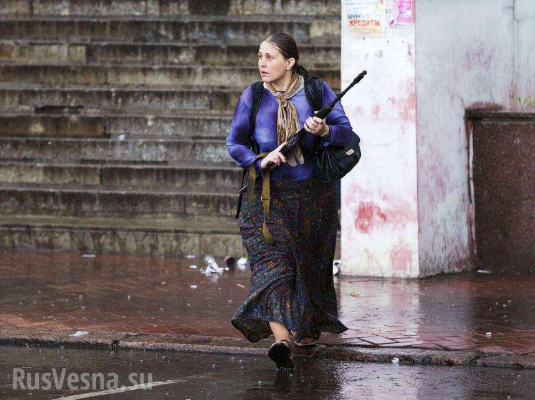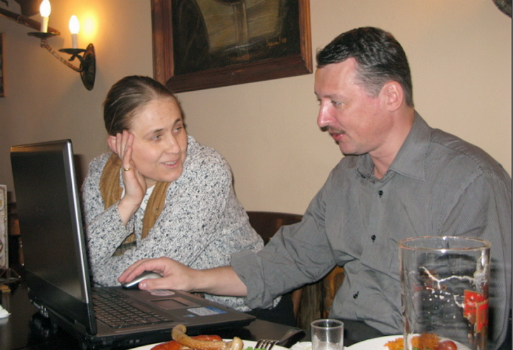
Portrait of Olga Kulygina with a “Kalashnikov”
from the Russian patriotic web site “RusVesna.su” (Russian Spring).
On September 30 Russian and Ukrainian media reported that, during a cease fire, there was an exchange of “prisoners of war” between pro–Russian militants and the Ukrainian government. The pro–Russian militants exchanged seventeen prisoners, including officers, for one woman – Olga Kulygina.
Russian citizen Olga Kulygina was captured in May when Ukrainian frontier guards destroyed a column transporting weapons from Russia to Ukraine. Kulygina was among those delivering the weapons and had $10,000 in her pocket.
Who is this woman?
The above photograph presented by “RusVesna.su” had been already used by Russian official media months earlier. Back then it was entitled: “Slavyansk mothers take guns to replace their sons killed by Ukrainian nationalists”.
Today nobody calls Muscovite Kulygina “Slavyansk mother”. Two different versions of her biography are re-posted now by numerous Russian web sites. They are taken from two different sources.
According to the version presented by the Russian site Davnim-Davno
Kulygina was born on September 14, 1972.
She lives in Moscow with a 77-year-old mother and 13-year-old son.
In 1989-1994, she studied at the Moscow State Institute of Applied Biotechnology (then this Institute was named differently – Moscow Technological Institute of the meat and dairy industry). In 2001 she got her doctoral degree with thesis on “Hematologic and cytogenetic effects of the Chernobyl accident on the three species of rodents living in the contaminated zone.”
She has taught in several Universities. From 2012 she was a professor at Plekhanov University, the most prestigious Russian school of economics. She teaches “strategic management” and works as a director of the University’s “Center of Technologies and Matrixes of Influence”.
She works as a journalist as well. In 2012 she was sending to Russian press pro-Assad correspondences from Syria.
The article published in “Davnim-Davno” doesn’t explain what Kulygina was doing in Ukraine.
Another version of her bio is presented in the web site “Censor.net” by the site’s creator and editor Yuri Butsov, a very popular young Ukrainian journalist.
According to Butusov’s report, Kulygina is one of the leaders of an agents’ network that the Russian security services has infiltrated into Russian nationalist groups. The services are used as recruiting stations for the formation of subversive groups and also to control the radical revolutionary movement in Russia.
She played an important role in organizing the Russian security services’ operations in support of the terrorist groups in Syria, Transdniestria, Georgia and Ukraine. She is also a close friend of FSB colonel Igor Strelkov, the organizer and former commander of pro-Russian terrorist army and FSB Major-General Alexander Borodai, former self-proclaimed head of Donetsk government.

Kulygina and Strelkov
Yuri Butusov writes:
“For many years she was involved in the Russian secret services operations in Transdnistria and Georgia, helped in suppressing the anti-Yeltsin rebellion in Moscow in 1993, executed tasks in support of Assad’s terrorist regime in Syria, infiltrated into Barkashov anti-Yeltsin teams’ leaders. She was one of planners and organizers of the invasion in Ukraine, personally participating bearing arms in Strelkov’s subversive group, which seized Sloviansk.
“Kulygina could become a very valuable witness at the trial over the organizers of the Russian invasion of Ukraine. Not all Ukrainian Security service agencies’ employees supported the decision to let Kulygina go”.
Which version of Kulygina’s bio is closer to the truth? No doubt the version presented by Yuri Butusov better explains why seventeen military men were exchanged for this one woman.

